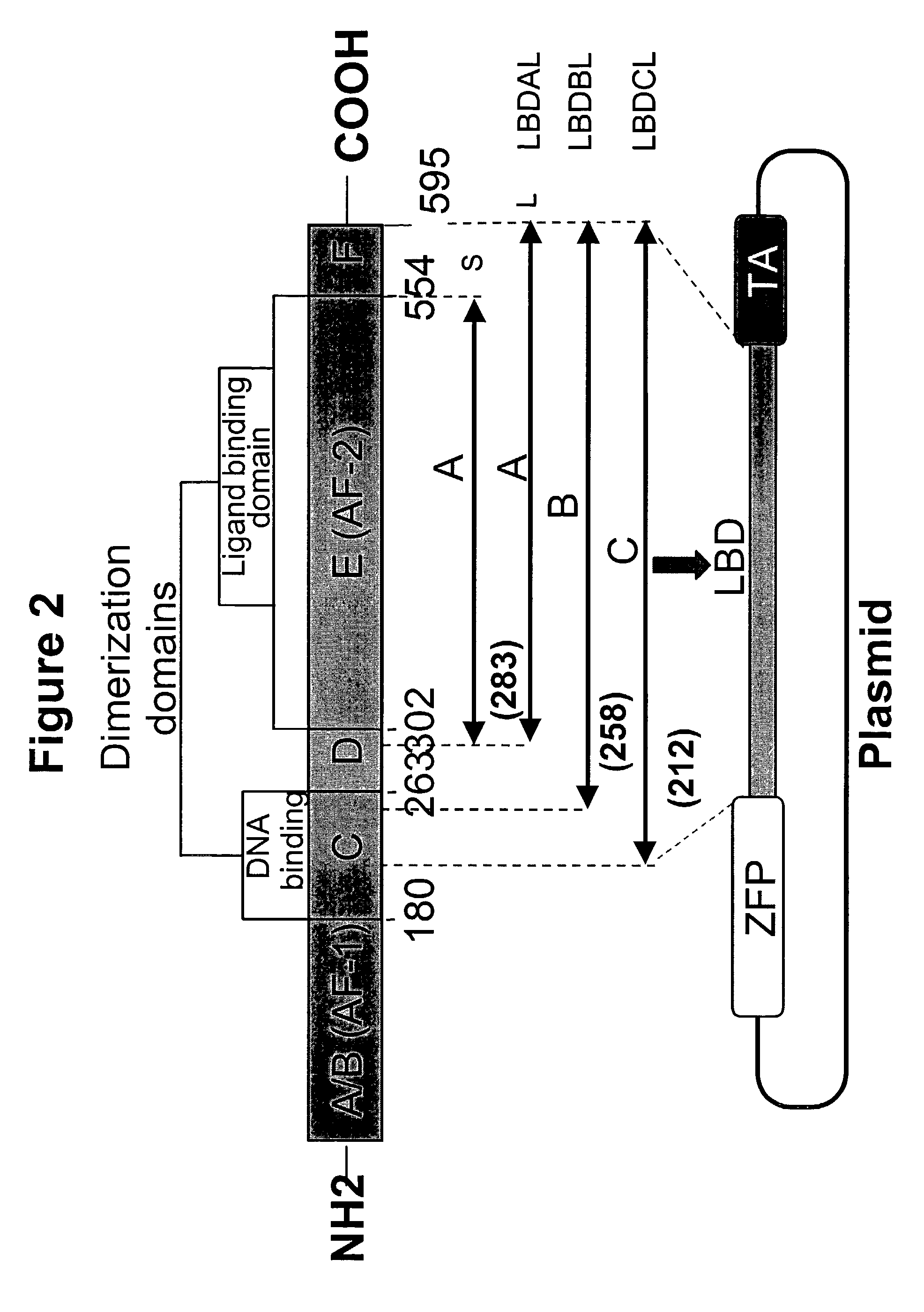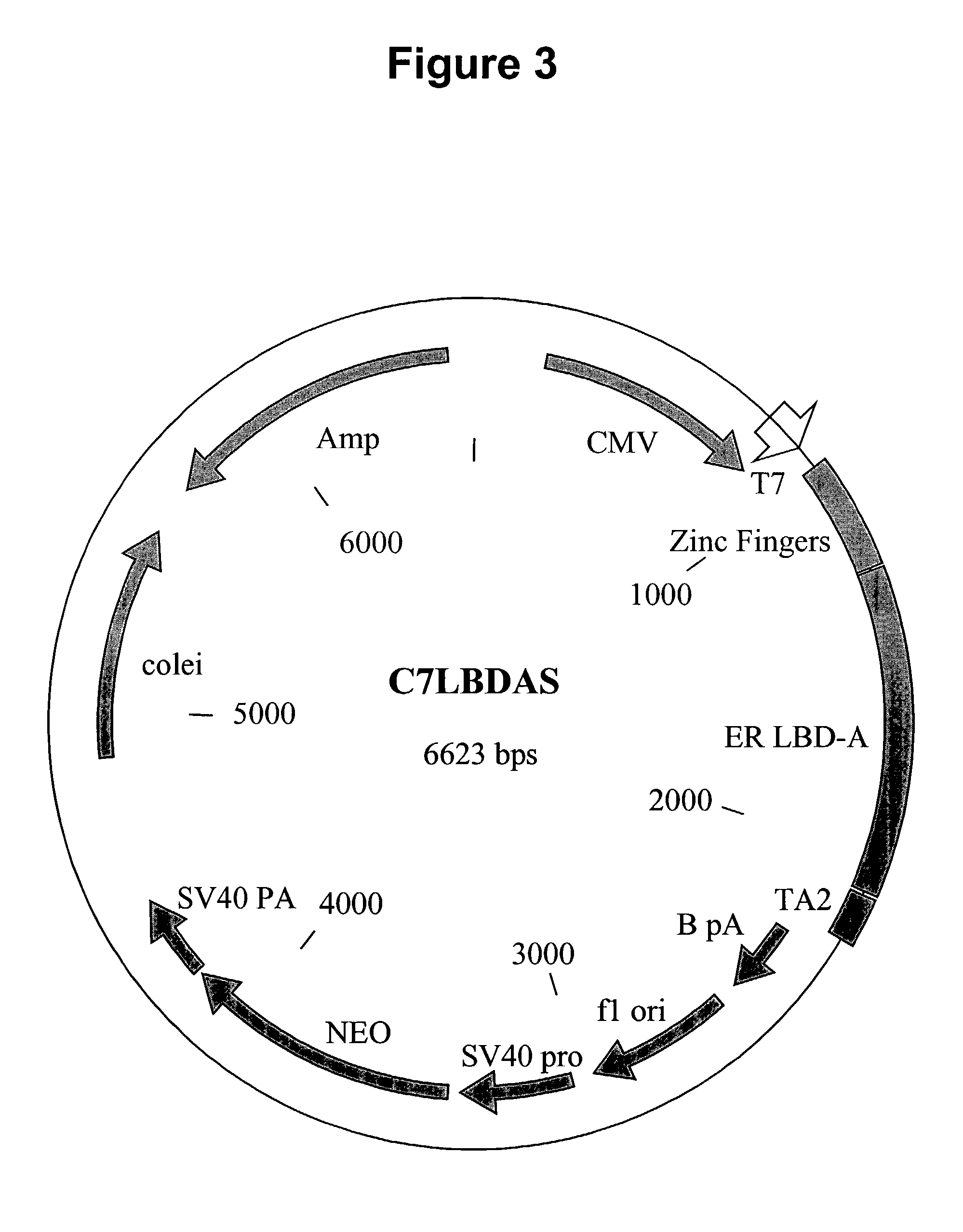Nucleic acids encoding estrogen receptor ligand binding domain variants
a technology of estrogen receptor and binding domain, which is applied in the field of nucleic acids encoding estrogen receptor ligand binding domain variants, can solve the problems of lack of significant agonist or antagonistic action of synthetic ligands
- Summary
- Abstract
- Description
- Claims
- Application Information
AI Technical Summary
Benefits of technology
Problems solved by technology
Method used
Image
Examples
example 1
Ligand-dependent Regulation of Transgene Expression by ZFP-LBD Fusion Proteins
[0265]In order to evaluate the ability of the fusion proteins C7LBD A, B, and the related LBD mutants to regulate transgene expression, a standard co-transfection reporter assay was performed. A reporter construct, henceforth known as 6×2C7pGL3Luc, containing six copies of a directly repeated C7 binding site (6×2C7) inserted upstream of an SV40 promoter fragment and reporter gene encoding firefly luciferase (pGL3Pro; Promega) was transfected along with the designated fusion protein and assayed as described below. Note the consensus C7 binding site is 5′-GCG TGG GCG-3′.
[0266]Cultured cells (HeLa, Cos, Hep3B or other) were seeded at 5×104 cells / well in a 24 well plate prior to the day of transfection in DMEM Phenol-free media, supplemented with L-glutamine and 5% (v / v) charcoal-dextran stripped Fetal Bovine serum (sFBS). Cells were transfected using the Qiagen Superfect Transfection ...
example 2
Adenoviral Vectors
Construction and Evaluation of the Cys2-His2 Zinc Finger DBD-ER LBD Regulators in Adenoviral Vectors
[0269]To deliver the two components of the regulatory system to mammalian cells, either ex vivo or in vivo, a series of adenoviral vectors were constructed. These vectors contained either the ZFP-LBD fusion protein regulator linked to the immediate early CMV promoter or the regulatable transgene, linked to the 6×2C7 array of C7 binding sites and the minimal promoter from SV40 or c-fos TATA as described previously. The fusion protein regulator vector and regulatable transgene vector are then mixed at various ratios and delivered to cells or animals by standard methods. The methods described here can be used to construct and evaluate any of the mutated LBD variants that are the subject of this application.
[0270]Construction of an adenovirus vector is routine and generally, the procedure involves three main steps: first a shuttle plasmid containing the viral left ITR, v...
example 3
Lentiviral Vectors
Construction and Evaluation of the Cys2-His2 Zinc Finger DBD-ERLBD Regulators in Lentiviral Vectors
[0279]In order to demonstrate controlled gene expression in an integrated vector system, a regulatory system (e.g. C7LBD-As(G521R) similar to that described in the previous adenoviral vector example (Example 2) can be used to develop a series of lentiviral vectors. These vectors preferably contain either the ZFP-LBD fusion protein linked to the immediate early CMV promoter or a regulatable transgene (either eGFP or luciferase) linked to the 6×2C7 array of C7 binding sites and either the minimal promoter from SV40 or the C-fos gene minimal TATA box region. The fusion protein-encoding vector and the regulatable transgene vector can then be used to generate lentiviral vector supernatant. The supernatant can be used to stablely transduced human cells either singly or in parallel. Stable cell lines containing the integrated vectors can then be induced with the appropriate ...
PUM
| Property | Measurement | Unit |
|---|---|---|
| Molar density | aaaaa | aaaaa |
| Molar density | aaaaa | aaaaa |
| Density | aaaaa | aaaaa |
Abstract
Description
Claims
Application Information
 Login to View More
Login to View More - R&D
- Intellectual Property
- Life Sciences
- Materials
- Tech Scout
- Unparalleled Data Quality
- Higher Quality Content
- 60% Fewer Hallucinations
Browse by: Latest US Patents, China's latest patents, Technical Efficacy Thesaurus, Application Domain, Technology Topic, Popular Technical Reports.
© 2025 PatSnap. All rights reserved.Legal|Privacy policy|Modern Slavery Act Transparency Statement|Sitemap|About US| Contact US: help@patsnap.com



